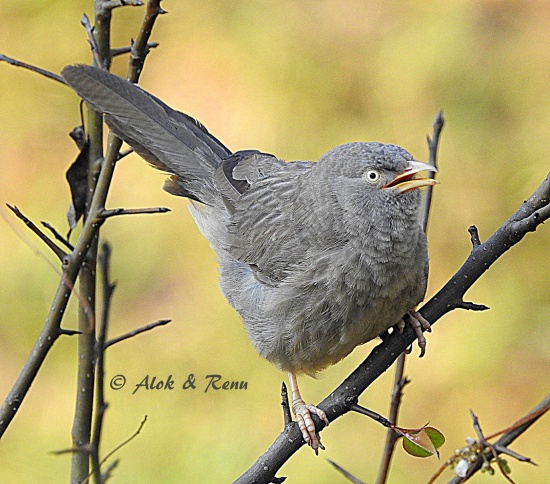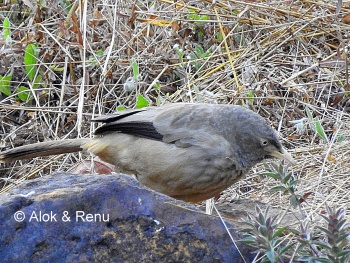Alternative names: Striated Babbler; Deccan Babbler (somervillei)

Photo © by Alok Tewari
Dwarahat, Dist. Almora, Uttarakhand Himalayas, India, 17 October 2016
- Argys striata
Turdoides striata
Identification
25cm (9¾ in). The most widespread Turdoides-babbler of the Indian Subcontinent.
- Drab grey plumage
- Yellow bill
- Pale lores
- Pale yellowish eyes
Other plumage markings are variable and diffuse.
Juveniles are browner-tinged overall.
Similar species
Yellow-billed Babbler has pale bluish eyes and pale panel on wing. All other Turdoides-babblers of the region don't have a yellow bill and most of them are much more streaked.
Distribution
India, Nepal, Bhutan and Pakistan.
Common in most of its range.
Taxonomy

Photo © by Alok Tewari
Bhimashankar WLS, Western Ghats, Dist. Pune, Maharashtra, India, 24 January 2016
This is a polytypic species[3] consisting of 5 subspecies.
May form a superspecies with Orange-billed Babbler and has been considered conspecific with it.
The scientific name was formerly spelled Turdoides striatus.
Subspecies
- A. s. sindiana':
- A. s. striata:
- A. s. orientalis:
- Central and southern India
- A. s. malabarica:
- Southwest India from Goa to Kerala
- A. s. somervillei:
- Coastal western India (Surat Dangs to Goa)

Photo © by Alok Tewari
Keoladeo National Park, Bharatpur, Rajasthan, India, 23 December 2021
Habitat
Found in a wide variety of habitats from open and secondary forest to scrubland, plantations, orchards, hedges in cultivation or bushes in waste ground..
Locally up to 1830m.
Behaviour
Diet
Feeds mainly on insects but takes also frogs, grain, seeds, berries and nectar.
Gregarious and often in big groups of 6 to 12 birds or in mixed-species flocks, sometimes mixing with Yellow-billed Babbler. Usually foraging on the ground.
Breeding
Breeding season all year, peak time from February to October. The nest is a loose, deep or shallow cup, made of grasses. It's placed in a bush, hedge or in a small tree. 3-7 deep greenish blue eggs are laid.
Resident species.
Vocalisation
Recording © by Alok Tewari
Dwarahat, Dist. Almora, Alt. 5500 ft. above MSL, Uttarakhand, India, Oct.-2016
Call given by two individuals from a tree-perch.
References
- Del Hoyo, J, A Elliott, and D Christie, eds. 2007. Handbook of the Birds of the World. Volume 12: Picathartes to Tits and Chickadees. Barcelona: Lynx Edicions. ISBN 978-8496553422
- Rasmussen, PC and JC Anderton. 2005. Birds of South Asia: The Ripley Guide. Barcelona: Lynx Edicions. ISBN 978-8487334672
- Clements, J. F., T. S. Schulenberg, M. J. Iliff, S. M. Billerman, T. A. Fredericks, J. A. Gerbracht, D. Lepage, B. L. Sullivan, and C. L. Wood. 2021. The eBird/Clements checklist of Birds of the World: v2021. Downloaded from https://www.birds.cornell.edu/clementschecklist/download/
Recommended Citation
- BirdForum Opus contributors. (2025) Jungle Babbler. In: BirdForum, the forum for wild birds and birding. Retrieved 26 April 2025 from https://www.birdforum.net/opus/Jungle_Babbler
External Links
GSearch checked for 2020 platform.1






